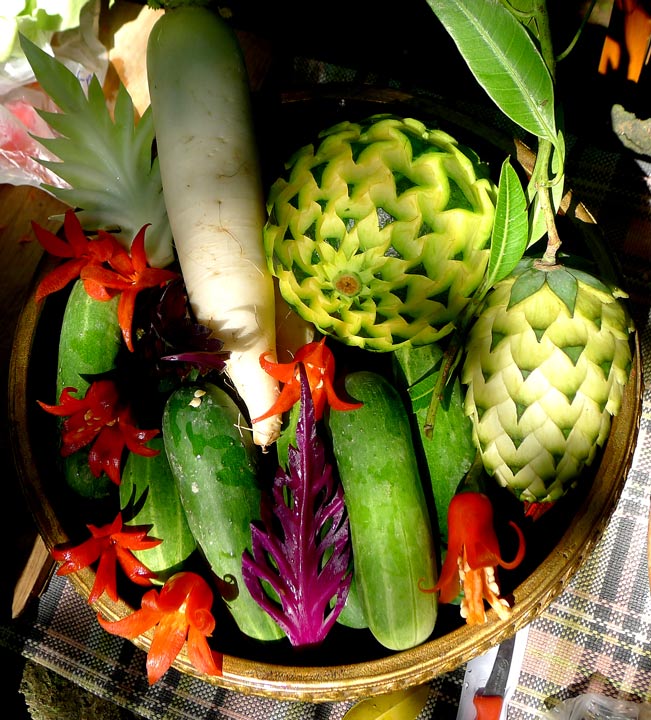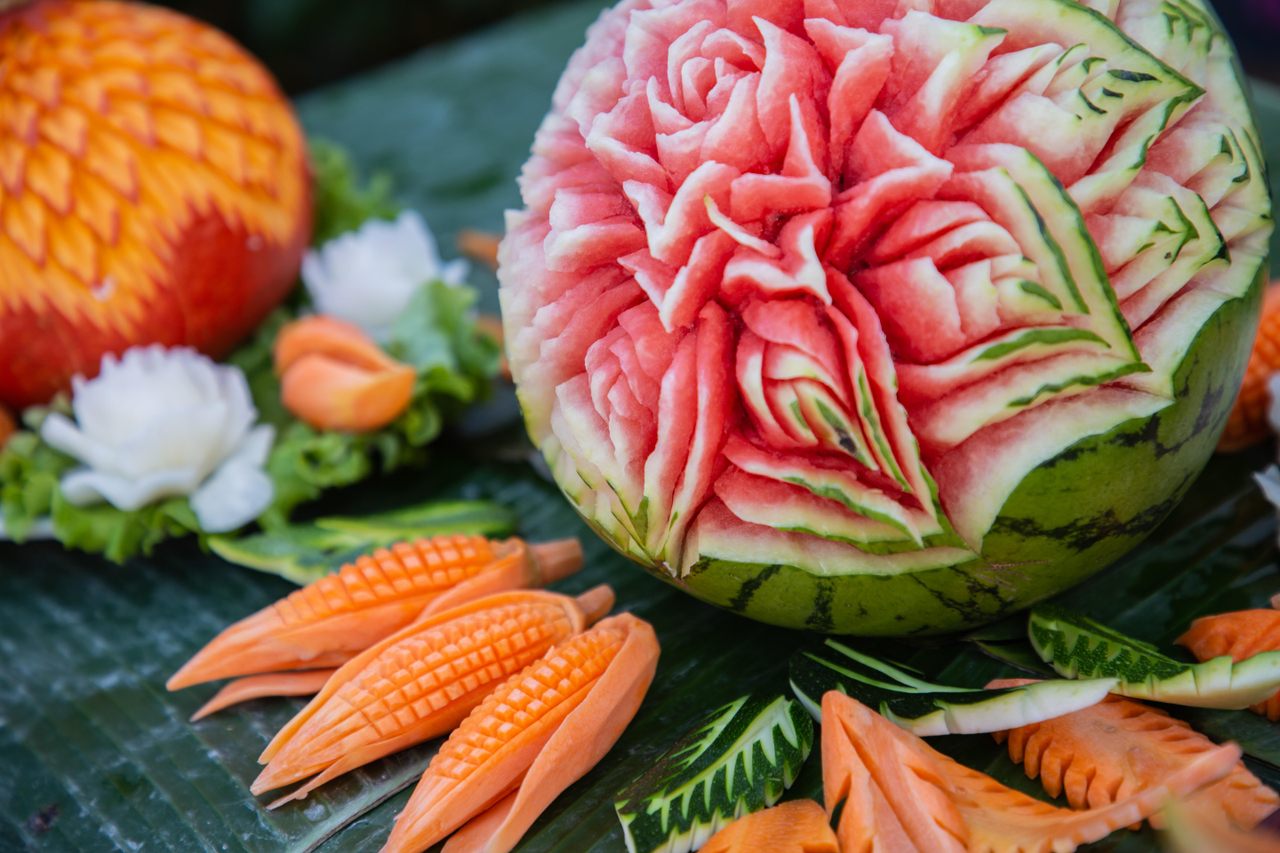If you have ever feasted your eyes on a beautifully carved fruit or vegetable, chances are you have witnessed the mesmerizing artistry of Thai fruit and vegetable carving. This ancient technique, deeply rooted in Thai culture, has captivated people from all over the world with its intricate designs and delicate craftsmanship. From intricately carved watermelons that resemble blooming flowers to remarkably detailed pumpkin sculptures, this unique Thai art form has become a prominent feature in culinary displays, tourist attractions, and even special occasions. With Thailand’s rich history, diverse cuisine, and stunning landscapes, it’s no wonder that this art form has become an integral part of the country’s cultural tapestry. In this article, we will take a closer look at the captivating world of Thai fruit and vegetable carving and explore the fascinating techniques behind this remarkable art.
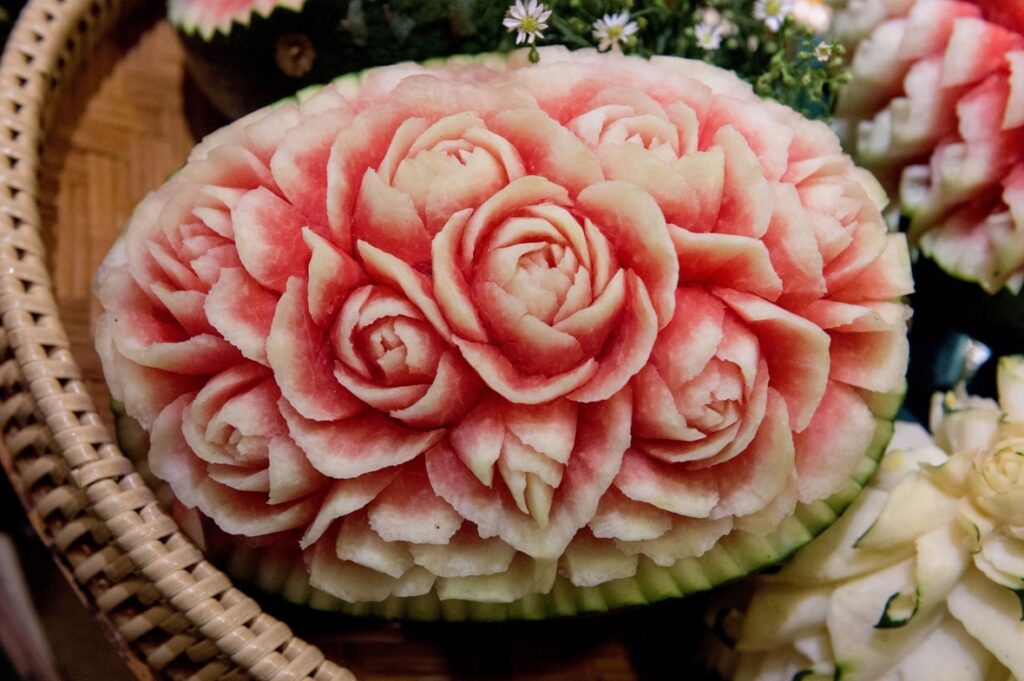
History of Thai Fruit and Vegetable Carving
Origins of fruit and vegetable carving in Thailand
Thai fruit and vegetable carving has a long and rich history that dates back centuries. The exact origins of this art form are difficult to trace, but it is believed to have originated in the ancient Siamese kingdoms of Sukhothai and Ayutthaya. Carvings adorned royal dishes and were presented as gifts to visiting dignitaries.
Influence of Buddhist traditions on Thai carving
The practice of fruit and vegetable carving in Thailand has been greatly influenced by Buddhist traditions. Buddhism teaches the importance of mindfulness and the appreciation of beauty in everyday life. Thai carvers apply these principles to their craft, creating intricate and delicate designs that reflect the beauty of nature and the impermanence of all things.
Evolution and development of Thai carving techniques
Over the centuries, Thai fruit and vegetable carving techniques have evolved and developed, resulting in the stunning art form we see today. Early carvings were simple and primarily used for decorative purposes. However, as the art form gained popularity and recognition, Thai artisans began to experiment with more complex designs and techniques, pushing the boundaries of what was thought possible with fruits and vegetables.
Importance of Fruit and Vegetable Carving in Thai Culture
Symbolism and meaning behind Thai carving
Thai fruit and vegetable carving holds deep symbolic meaning in Thai culture. Each design and motif carries its own significance, often representing prosperity, fertility, or protection against evil spirits. These carvings are believed to bring good luck and blessings to those who behold them, making them an integral part of Thai culture and folklore.
Role of carving in Thai festivals and ceremonies
Fruit and vegetable carving plays a significant role in Thai festivals and ceremonies. Whether it’s the intricate carvings displayed during the annual Loi Krathong festival or the stunning creations adorning the tables of royal banquets, these carvings add a touch of beauty and elegance to the celebrations. They serve as an offering to deities and ancestors, symbolizing gratitude and respect.
Impact of carving on Thai culinary traditions
Thai fruit and vegetable carving has had a profound impact on the country’s culinary traditions. It has transformed the way Thai cuisine is presented, elevating it from mere sustenance to a work of art. Carved fruits and vegetables are often used as decorative garnishes, enhancing the visual appeal of dishes and delighting diners with their intricate details. By incorporating carving into their culinary practices, Thai chefs demonstrate their creativity and attention to detail.
Popular Fruits and Vegetables Used in Thai Carving
Mangoes
Mangoes are one of the most popular fruits used in Thai carving. Their vibrant colors and smooth texture make them an ideal canvas for intricate designs. Carvers often transform mangoes into delicate flowers, butterflies, or traditional Thai motifs, showcasing the versatility of this tropical fruit.
Watermelons
Watermelons are another favorite among Thai carvers due to their large size and refreshing taste. With their green rind and bright red flesh, watermelons provide a colorful base for intricate carvings. From intricate patterns resembling lacework to intricate animal figures, watermelons are transformed into stunning masterpieces, adding a visual feast to any table.
Pumpkins
Pumpkins are not only delicious but also serve as a popular medium for Thai carving. During the annual Thai festival of Loy Krathong, pumpkins are carved into traditional lantern shapes and illuminated with candles. These pumpkin lanterns are then released onto the water, symbolizing the floating away of negativity and the welcoming of a brighter future.
Carrots
Carrots are a versatile vegetable that can be easily carved into various shapes. Thai carvers often utilize carrots to create intricate flowers, leaves, and animals. Due to their vibrant orange color and firm texture, carrots can be transformed into visually stunning creations, adding an element of surprise and beauty to any dish they adorn.
Radishes
Radishes are commonly used in Thai carving to create small, intricate designs. The white flesh and vibrant red skin of radishes allow for precise carving, making them perfect for creating detailed patterns and delicate flowers. Radish carvings are often used as decorative garnishes, adding a touch of elegance and sophistication to Thai dishes.
Tools and Techniques of Thai Fruit and Vegetable Carving
Specialized carving knives and tools
Thai fruit and vegetable carving requires a set of specialized knives and tools. These tools are designed to assist carvers in creating precise and intricate designs. The most common tools used include paring knives, channel knives, and melon ballers. Each tool serves a specific purpose, allowing carvers to achieve the desired shapes and textures in their creations.
Selection and preparation of fruits and vegetables
The selection and preparation of fruits and vegetables are crucial steps in Thai carving. Carvers carefully choose produce that is ripe, firm, and has a smooth skin or rind. Before carving, the fruits and vegetables are thoroughly washed and dried to ensure a clean canvas. Additionally, the carver must have a keen understanding of the produce’s texture and structure to achieve the desired results.
Different carving techniques and styles
Thai fruit and vegetable carving encompasses a variety of techniques and styles. Traditional Thai carving techniques include chip carving, relief carving, and freehand carving. Chip carving involves removing small chips of the fruit or vegetable to create intricate patterns, while relief carving involves carving designs in shallow relief on the surface. Freehand carving allows for more creative expression, enabling carvers to create intricate three-dimensional sculptures.
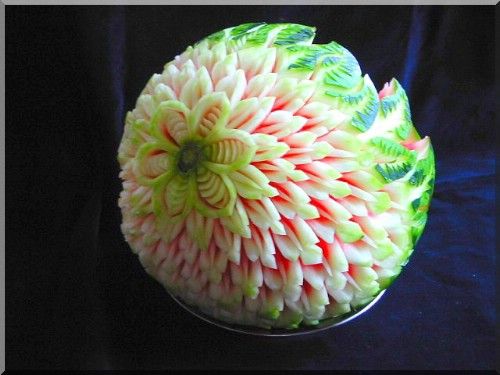
Step-by-Step Guide to Creating Thai Fruit and Vegetable Carvings
Choosing a design or pattern
The first step in creating a Thai fruit or vegetable carving is selecting a design or pattern. Carvers can draw inspiration from nature, traditional Thai motifs, or their own imagination. It is important to choose a design that suits the shape and size of the fruit or vegetable being carved, as well as the level of skill of the carver.
Preparing the fruit or vegetable
Before carving, the fruit or vegetable must be washed and dried. This ensures a clean surface for carving and helps the carving tools glide smoothly. The fruit or vegetable should also be chilled to maintain its shape and firmness, making it easier to carve.
Basic carving techniques for beginners
For beginners, it is best to start with simple carving techniques. A paring knife is used to remove the skin or rind of the fruit or vegetable, creating a smooth surface for carving. Chip carving is a common technique for beginners, involving carefully removing small chips of the fruit or vegetable to create patterns and designs.
Advanced carving techniques for experienced artists
As carvers gain experience and skill, they can explore more advanced carving techniques. Relief carving allows for the creation of intricate designs in shallow relief on the surface of the fruit or vegetable. Freehand carving permits artists to sculpt three-dimensional figures, giving their carvings a lifelike quality. These techniques require precision, patience, and a deep understanding of the medium being carved.
Thai Fruit and Vegetable Carving as a Form of Artistic Expression
Appreciation of Thai carving as a visual art form
Thai fruit and vegetable carving is widely appreciated as a visual art form. The intricate designs and delicate details displayed in these carvings captivate viewers, leaving them in awe of the skill and creativity of the carver. Thai carving is not just about creating beautiful objects but also about evoking emotions and telling stories through the mastery of fruit and vegetable manipulation.
Integration of Thai carving in contemporary art
Thai fruit and vegetable carving has found its place in contemporary art, transcending the traditional boundaries of the craft. Thai artists have used fruit and vegetable carving as a medium for expressing social and cultural commentary. By pushing the boundaries of the art form and experimenting with new techniques and materials, contemporary Thai carvers continue to elevate the craft to new heights.
Recognition of Thai carving as cultural heritage
Thai fruit and vegetable carving has been recognized as an important part of Thailand’s cultural heritage. It has been included in UNESCO’s Representative List of the Intangible Cultural Heritage of Humanity, ensuring its preservation and promotion for future generations. This recognition highlights the cultural significance and artistic value of Thai carving, solidifying its place in the world of art and craftsmanship.
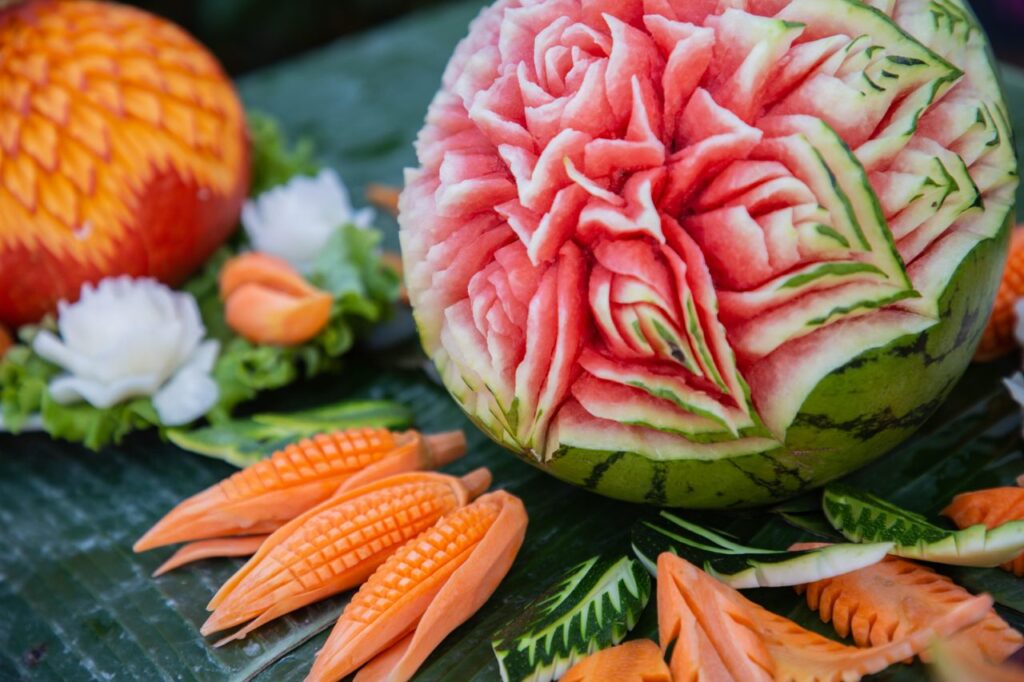
The Role of Thai Fruit and Vegetable Carving in Culinary Presentation
Enhancing the visual appeal of Thai dishes
Thai fruit and vegetable carving plays a vital role in enhancing the visual appeal of Thai dishes. Carved fruits and vegetables are used as decorative garnishes, adding a pop of color and texture to the plate. Whether it’s a meticulously carved cucumber flower or an intricately carved watermelon centerpiece, these garnishes elevate the presentation of Thai cuisine, enticing diners with their beauty.
Carving techniques for decorative garnishes
Carvers employ various techniques to create decorative garnishes for Thai dishes. From radish roses and carrot rosettes to cucumber fans and pineapple boats, the possibilities are endless. These garnishes not only add visual appeal but also provide a burst of flavor and freshness to the dish. The addition of a beautifully carved garnish can transform an ordinary plate of food into a visually stunning masterpiece.
Influence of Thai carving on international culinary trends
Thai fruit and vegetable carving has had a significant influence on international culinary trends. As the appreciation for Thai cuisine grows worldwide, so does the demand for visually appealing dishes. Thai carving techniques have been adopted by chefs from different culinary traditions, who incorporate these techniques into their own cuisines. This cross-cultural exchange has led to the fusion of carving styles, resulting in innovative and visually striking culinary creations.
Challenges and Rewards of Learning Thai Fruit and Vegetable Carving
Difficulties faced by beginners
Learning Thai fruit and vegetable carving can be a challenging endeavor, especially for beginners. The intricate nature of the craft requires patience, precision, and a steady hand. Carvers must invest time and effort in mastering the use of carving tools and techniques. Moreover, the process of understanding the various fruits and vegetables and their specific properties can be daunting. However, with practice and perseverance, beginners can overcome these challenges and develop their skills.
Importance of patience and precision in carving
Patience and precision are essential qualities for success in Thai fruit and vegetable carving. Each cut and carving stroke must be executed with care and precision to achieve the desired result. Rushing through the process can lead to mistakes and uneven carvings. It is essential for carvers to embrace the slow and meticulous nature of the craft, finding joy in the process of creation.
Personal satisfaction and sense of accomplishment
Despite the challenges, learning Thai fruit and vegetable carving brings immense personal satisfaction and a sense of accomplishment. As carvers develop their skills and create increasingly intricate designs, they experience a deep sense of pride in their creations. Sharing their carvings with others and seeing the joy and appreciation it brings further reinforces the rewards of mastering this art form.
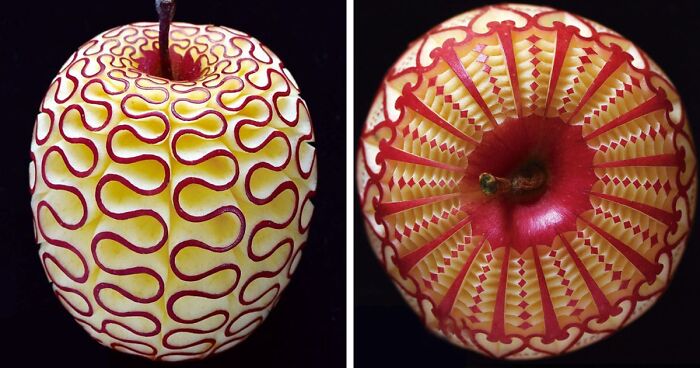
Promoting Thai Fruit and Vegetable Carving to Preserve the Tradition
Efforts to pass down carving techniques to younger generations
To preserve the tradition of Thai fruit and vegetable carving, efforts have been made to pass down the techniques to younger generations. Master carvers and artisans conduct workshops and classes, teaching the fundamentals of carving and inspiring the next generation to embrace this art form. By imparting their knowledge and skills, these mentors ensure that the tradition continues to thrive and evolve.
Carving workshops and classes for enthusiasts
Carving workshops and classes have become popular among carving enthusiasts and those interested in Thai culture. These workshops provide a hands-on experience, allowing participants to learn the techniques and intricacies of Thai fruit and vegetable carving directly from skilled artisans. Such workshops serve as a platform for cultural exchange, fostering an appreciation for Thai carving and promoting cross-cultural understanding.
Integration of carving in tourism and cultural promotion
The art of Thai fruit and vegetable carving has become an integral part of Thailand’s tourism and cultural promotion efforts. Craft markets, food festivals, and cultural events prominently feature carved fruits and vegetables, showcasing the beauty and versatility of Thai carving. The inclusion of carving demonstrations and workshops in tourism packages further exposes visitors to this unique art form, encouraging them to explore and appreciate Thailand’s rich cultural heritage.
Thai Fruit and Vegetable Carving Competitions and Events
Annual nationwide carving competitions in Thailand
Thailand hosts annual nationwide carving competitions, attracting talented carvers from across the country. These competitions celebrate the artistry and skill of Thai fruit and vegetable carving, allowing carvers to showcase their creativity and technique. The competitions feature various categories, ranging from beginner to advanced, ensuring that both newcomers and seasoned carvers have an opportunity to participate and be recognized for their talent.
International exhibitions showcasing Thai carving talent
Thai fruit and vegetable carving has gained international recognition, with exhibitions and showcases held around the world. These exhibitions feature the works of Thai carvers, highlighting their exceptional talent and skill. The intricate and awe-inspiring carvings displayed in these exhibitions serve as a testament to the mastery and artistry of Thai carving.
Celebratory events featuring live carving demonstrations
Live carving demonstrations are a popular feature of celebratory events in Thailand. These events provide an opportunity for visitors to witness the intricate process of Thai fruit and vegetable carving firsthand. Skilled carvers perform their craft in front of an audience, mesmerizing them with their precision and creativity. These live demonstrations serve to educate and inspire, fostering a deeper appreciation for Thai carving and its cultural significance.
In conclusion, Thai fruit and vegetable carving is a captivating art form that has flourished throughout Thailand’s rich history. Its origins can be traced back to ancient Siamese kingdoms, and it has been greatly influenced by Buddhist traditions. Thai carving has evolved over time, becoming an integral part of Thai culture and culinary traditions. This art form holds deep symbolic meaning and is showcased during festivals and ceremonies. Popular fruits and vegetables such as mangoes, watermelons, pumpkins, carrots, and radishes are often used as mediums for carving. Thai carving techniques require specialized tools, precise selection, and preparation of produce, as well as the mastery of various carving techniques and styles. Fruit and vegetable carving is not only appreciated as a visual art form, but it has also found its place in contemporary art and is recognized as an important part of Thailand’s cultural heritage. Thai carving enhances the visual appeal of Thai dishes and has influenced international culinary trends. Learning Thai carving comes with its challenges but brings personal satisfaction and a sense of accomplishment. Efforts to preserve this tradition include passing down carving techniques to younger generations, organizing workshops and classes, and integrating carving into tourism and cultural promotion. Thai fruit and vegetable carving competitions, international exhibitions, and live carving demonstrations further showcase the beauty and talent of Thai carving. Through these efforts, this intricate art form continues to thrive and captivate audiences around the world.
